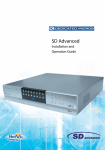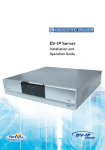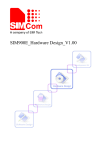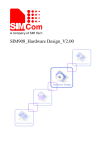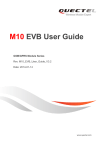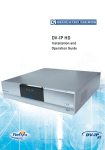Download EcoSense Quick Start Guide
Transcript
Quick Start Guide The following Quick Start Guide will help you through the initial installation, configuration and operation of the EcoSense. The unit supports 17 normally open/ closed alarm inputs, or one Global keyswitch. Use this document in conjunction with the Installation & Operation Guide. This is located on the Product CD supplied with the unit and can also be found on the Dedicated Micros website (dedicatedmicros.com). Note: The 4 channel unit supports 5 normally open/closed alarm inputs. The unit supports up to two 24V 200mA relays. Check the contents of the box Remove the packaging and check all items listed below are present. • EcoSense DVR (either 4, 8, or 16 input) • IR Remote Control • 12v DC Power Adaptor • EcoSense Software/Documentation CD • Quick Start Guide If any of these items are missing; please contact the Dedicated Micros Customer Service team on +44 (0) 845 600 9501 Installing The Unit The unit supports up to 4, 8 or 16 Video Inputs (dependant on model). These are connected via the 75Ω BNC connectors. Connect cameras to the video inputs starting from VID 1. Note: The 4 channel unit supports 1 relay input. Opening Menu When first accessing the unit, the main menu will be displayed. This menu allows access to the Configuration menus, the Viewer menus and also several Download options. Note: The Download options will only be available if viewing remotely via a network connection. Select the Configuration menu tab to access the unit’s Configuration menus. Refer to ‘Navigating the Configuration Menus’ for further guidance. Select the Viewer menu tab to access the unit’s Viewer function. Refer to ‘Operating The Viewer’ for further guidance. Connect the 12v DC power adaptor (supplied) to the unit and then to the wall socket, or to a fused spur connection. To be compliant with wiring regulations in some countries, an Alarm/Security device should be connected to a fused spur and not a wall outlet socket (check local regulations before installation). Select the Download menu tab to access the various Download sub-options. Navigating The Configuration Menus The configuration pages are navigated using the menu tree (displayed on the left of each page). Selecting one of the menu options will display the relevant page. Associated sub-menus will then be available Relevant menus can be accessed directly via the coloured softkey options shown at the base of each menu. The options available will depend on the menu being viewed. Select a softkey option by pressing either the corresponding button on the IR Remote Control (if viewing the menus locally), or by selecting the relevant option via the mouse (if viewing the webpages). Accessing The Configuration/Viewer Menus The unit can be configured either on the local monitor or over a network connection using a PC with Internet Explorer or similar web browser. Accessing the Configuration menus on a local monitor The Configuration pages can be displayed on the local monitor by pressing the MENU button on the IR Remote Control. The unit supports a main monitor via ‘MON A’. A spot monitor can also be connected via ‘MON B’. Note: If the IR Remote Control does not open the menu, press the DVR button to make sure it is in DVR mode, then press the MENU button. Note: Any changes are automatically saved when the page is closed. To ‘manually’ save changes, select the Save option. Accessing the Configuration/Viewer menus via a PC web browser Operating The Viewer The IP address of the unit is required to access the webpages. The DHCP assigned address can be identified via the local menu pages. Using the local monitor, press the MENU button on the IR Remote Control and navigate to the System menu. The DHCP IP address will be displayed. A fixed IP address can be assigned via the Network menu. The unit supports two channels of bidirectional audio. Connect the audio equipment to the phono sockets labelled AUDIO IN and AUDIO OUT. Select the ‘Viewer’ option from the Opening Menu to access the Viewer menus. Navigation is via a colour coded softkey system. The colour bar menu provides an intuitive approach to operator and installer alike. The coloured buttons on the IR Remote Control and front panel correspond to the menu options displayed on screen. To access the unit via DNS, the default address will be: <machine serial number>.<yourdomain>.com The <machine serial number> is displayed on the underside of the unit (and on the System menu page). <yourdomain> relates to the name assigned to your DNS network. The function of the buttons will change according to whether the unit is in Live or Playback mode. The default DNS address can be renamed via the Network menu. The unit supports a 10/100Mbps auto-detecting network port. Use a CAT5 cable to connect the unit to the network port labelled ‘NET’. • Launch Internet Explorer (or other web browser package). • Type the URL for the unit. • The opening menu page will be displayed. Video Help Video Help files are imbedded on the unit and offer step by step guidance on performing some of the most common tasks required of the EcoSense. Access the Video Help menu via the Viewer menus. The Help videos are divided into six categories; each category containing relevant videos. To play a video, first click directly on one of the six categories. If viewing remotely, use the Directional buttons and the OK button. A connected USB mouse can also be used. When a category is chosen, all associated videos will be listed. Select a video to play. Note: A speaker must be connected to the Audio OUT connection to hear the associated audio commentary. Quick Start Guide Using the IR Remote Control Press the MENU button to access configuration menus via a local monitor. The menu will have a red indicator highlighting the first option. Select a main menu heading to open a drop down list of further menus. Use the Directional buttons to navigate the menu screens. Press the OK button to start editing a field (the option will be outlined in green). Use the Up/Down Directional buttons to change the settings within an editable field. Press the OK button to accept a new setting. Softkey Guidance The IR Remote Control, front panel interface and optional Keyboard have a common user interface. In addition to the direct action keys (rewind, fast forward etc.) there are coloured Softkeys that are context sensitive and enable rapid access to required functions. To display the context sensitive Softkey functions at any time (when viewing on a local monitor), press any of the coloured keys on the IR Remote Control. Entering Alpha-Numeric Data via a Local Monitor Event Search Filter Numeric or text data is entered using the on-screen Virtual Keyboard (Arrow Key Editor). It is possible to filter the event search by time or type (alarm, activity or system). When vewing the Event List on a local monitor using an IR Remote Control: To display the Virtual Keyboard, navigate to the relevant text input box using the Directional buttons and double press the OK button twice on the IR Remote Control. The Virtual Keyboard is displayed. Use the Directional buttons to move between characters, use the OK button to select a character. Select ‘Submit’ to enter details, press ‘Cancel’ to exit without entering any text. • Use the Directional buttons on the IR Remote Control to navigate to the Event filter textbox. • Enter the required start and end times via the Virtual Keyboard (Arrow Key Editor). • If required, select via the checkbox options to display only a specific event type. If no checkboxes are selected, all types will be displayed. • The Event list can also be filtered by pressing the corresponding coloured Softkey: Alpha-numeric data can also be entered in either upper or lower case format by ‘multi-tapping’ a relevant button. For example, with the cursor located in the text entry window of the Virtual Keyboard, repeatedly tap button ‘2’ to cycle through the following characters: 2,A,a,B,b,C,c,2 etc. To select one of these characters, simply stop tapping the button when the chosen character is displayed. The cursor will then progress, ready for the next character entry. Note: A USB Keyboard (not supplied) can be connected via one of the USB ports on the unit. The USB Keyboard can then be used to enter alpha-numeric data via the local menus. Viewing The Menu Pages Remotely (or Locally with a USB Mouse) Navigate the menus by clicking the tabs displayed on the left of the menu headings (on the menu tree). The first option is highlighted with a red tab. Select a main menu heading to open a drop down list of further sub-options. Highlight an editable field by clicking on it directly. Using the optional Keyboards (DM/KBC1 & DM/KBC2) The unit can also be controlled using an optional Dedicated Micros keyboard (except the 4-way unit). This is connected via the KBD connector on the rear of the unit and provides excellent control of the unit’s functions. Using the Front Panel Interface The Configuration and Viewer menus can be navigated and edited via the unit’s front panel interface. Navigate the menu tree via the Up/Down Directional buttons. When a menu is highlighted, open by pressing the OK button. Use the Left/Right/Up/Down Directional buttons to move between fields. Select OK to start editing a field (the option will be outlined in green). Use the Up/Down Directional buttons to change the settings within an editable field. Use the OK button to accept a new setting. Use the colour bar (Red, Green, Yellow, Blue and Purple) to directly access the corresponding function displayed on the menu screen i.e. red panel to select the red option. Note: Please contact your regional Dedicated Micros representative for information on purchasing a supported Dedicated Micros keyboard. Access The Event List Alarms and activity detection are tagged and stored in the Event List for easy retrieval along with System events such as system start data and camera fails. Each event is labelled with an event type (alarm, activity or system) plus its time and date. To view an event from the Event list on a local monitor: • Press the EVENT button on the IR Remote Control. • Use the Up/Down Directional buttons to select the event required, the selected event is displayed in the preview window. • To view any additional pages of Event data, press the Yellow Softkey. Press the Green Softkey to view previous pages. • Press the PLAY button to view the selected event. • Press the EXIT or LIVE buttons to exit the Event List. • Press the Red softkey to open the Event Filter menu. Alarm - Red Activity - Green System - Yellow Archive Selection The Archive Selection menu allows images and events to be added to the Copy Event List. When vewing images in Playback mode on a local monitor using an IR Remote Control: • Press the COPY button on the IR Remote Control to mark the start of the archive point. Press COPY again to mark the end of the archive point. • • The recorded images withn the selected time period will now be available via the Copy Menu. Copy Menu Images and events can be copied to CD/DVD or USB Media for remote reviewing i.e. for evidential or monitoring purposes. To access the Copy menu on a local monitor, press the COPY button on the IR Remote Control: To Transfer Events/Images From the Copy Menu to a USB Device • Insert a USB Device into the USB port on the front of the unit. • Select USB from the Archive Media checkbox. • Select the Copy option (Red) to start archive. • Selected items are then saved to the USB device. • The USB export progress is displayed as a %. On completion the status will read ‘Archive Complete’. Note: It is recommended that the ‘Include viewer application’ checkbox be selected. when downloading events to USB or CD/DVD. To Transfer Events/Images From the Copy Menu to a CD/DVD • Insert a CD/DVD Device into the CD/DVD drive on the front of the unit. • Select CD/DVD from the Archive Media checkbox. • Select the Copy option (Red) to start archive. • Selected items are then saved to the CD/DVD. • The CD/DVD export status is displayed as a %. On completion the status will read ‘Archive Complete’. Note: It is recommended that the ‘Include viewer application’ checkbox be selected. when downloading events to USB or CD/DVD. MI-Q-ECS1-E1-1



